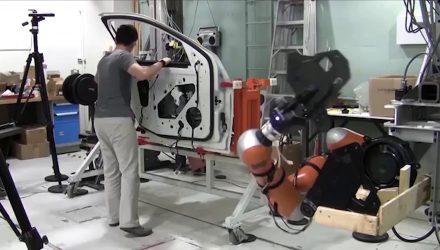ROS distributions are released every year and are supported for 24 months. This is good because it ensures that the most up-to-date code is always available. However, it is also a pain. Sometimes, we want more a more stable code-base to work from. ROS tackles this by releasing a Long Term Support (LTS) version every two years, which are supported for five years.
A new LTS distribution was released this year (Melodic Morenia LTS). However, we haven’t updated our ROS package for this version yet. According to a recent survey, 85% of users are using the Kinetic Kame release, and most people use the LTS distributions of ROS, not the bleeding edge version.
It takes time for people to adopt new distributions of ROS, so we are confident that the new Kinetic-compatible package will be suitable for most of our users for a couple of years at least.
What’s New About the Robotiq ROS Package
On the surface, not much has changed about the new ROS package. Most of the work has been done behind the scenes to bring the package up-to-date with the Kinetic release.
We have also been working on some bug-fixes.
However, we have made one rather large change…
The Packages have been Renamed
Probably the most obvious change is that many of the package names have been updated to match the real names of our products. This should hopefully sort some of the confusion that new users used to feel when they downloaded the package and were not sure which ones corresponded to their gripper.
Here are the major name changes we’ve made:
- Previously: robotiq_s_model — Now: robotiq_3f_gripper — We’ve updated the name of all the 3-Finger Gripper packages, which should save a lot of the confusion in future caused by the fact that we don’t call it the “s model” anywhere else.
- Previously: robotiq_c_model — Now: robotiq_2f_gripper — Similarly, the 2-Finger Grippers were rather confusingly called the “c model,” a term which we don’t use elsewhere.
- Previously: robotiq_arg2f_model — Now: robotiq_2f_140_gripper — The way we used to differentiate between the 2F-85 and 2F-140 2-Finger Grippers was to call the 140 version the “arg2f.” I’m sure many programmers shouted “aaarg” as they tried to work out what this meant. We have replaced this with the clearer term “2f_140.” However, we are still using the term “robotiq_2f_c2_gripper” because this refers to an older version of our 2F-85 gripper.
- Previously: robotiq_force_torque_sensor —> Now: robotiq_ft_sensor — Finally, we have renamed the package for our FT300 Force Torque Sensor to be a bit shorter.
What Functionalities are Available for the 3-Finger Gripper?
The Robotiq package includes functionality for all three of our grippers and the force-torque sensor. However, because the 3-Finger Gripper is the most popular among researchers we have more functionality for this.
Here are the different packages which allow you to control the 3-Finger Gripper and simulate it using the Gazebo simulator which is commonly used with ROS:
- Articulated Gazebo (robotiq_3f_gripper_articulated_gazebo & plugins) — Loads up the articulated model of the gripper into an empty Gazebo simulation.
- Messages (robotiq_3f_gripper_msgs) — Defines the input and output messages for the gripper. There are 22 command values that you can use in the input, ranging from setting the position to reading the current of an individual finger, and 18 output values.
- Control (robotiq_3f_gripper_control) — This is where it all happens. The various input and output values are grouped into easily usable commands like “enter pinch mode”, “open”, “go to that position”, etc
- Joint state publisher (robotiq_3f_gripper_joint_state_publisher) — This is a required package which is used by Gazebo and other visualization tools in ROS. joint_state_publishers simply convert the finger position into named joint values.
- Visualization (robotiq_3f_gripper_visualization) — This includes the 3D models for the simulation.
